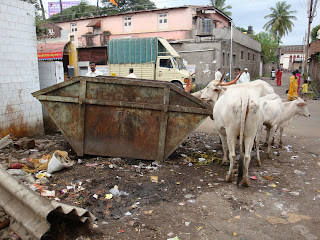I spent the last two days in Sangli, which is a small town 3.5 hours south of Pune where Shelter Associates is working on a big project at the moment. Shelter has been working in the slums of Sangli for a long time now, and one of the biggest problems in slums is that people don’t have toilets. One of their first projects there was a community toilet project in
Sangalwadi in 2002. Sangalwadi is a slum with about 256 people in 55 houses, and they built a toilet block with facilities for men and women, with living quarters for the caretaker (and family) in between. We only saw the women’s side, which has 4 communal toilets and 4 private toilets.
Next we visited Jatkar Samaj, where Shelter Associates did an individual toilet project in 2006-7. This is the ideal situation, where every house has its own toilet, but it’s too expensive to implement in all slums. Anyway, with Friends of Shelter Associates (http://www. friendsofsa.org/) funding, they built just over 100 toilets for 137 houses in Jatkar Samaj.
Finally, we visited Kolhapur Chawl, where Shelter recently (2008) did another
community toilet and water tank project for 135 families. They also built a bio-gas tank next to the toilets that produces enough gas for a hand-full of houses, but only one is connected at the moment. In this toilet block the caretaker (and family) lives in a room above the toilets, so we got a birds-eye view over the slum. You can really see the conditions in which people are living here; the roofs are made of broken tiles, tarpaulin and corrugated sheets; those that have electricity probably steal it from the power line overhead; many houses got running water from the community toilet project, but none have access to a gas line so they cook using wood or coal.

|

|
Surprisingly the streets and houses in the slums are clean compared to the rest of India (post about that to come next time). The people don’t have money for basics like proper roofs, toilets, water or electricity, but they still take pride in the place they live. They smile at us when we come to visit, invite us in and offer us tea. We never have time to stay, but even if we did I would feel bad drinking their tea in case they can’t afford to buy more.
This isn’t the India most people see when they come here for vacation or travelling. I knew I was coming to India to work on slums, but you can’t really prepare yourself for seeing it first hand when you come from a place where everyone has so much. Access to a toilet with running water isn’t even an issue you think about back home. You can’t really describe it properly in a blog post, how people live with so little.























